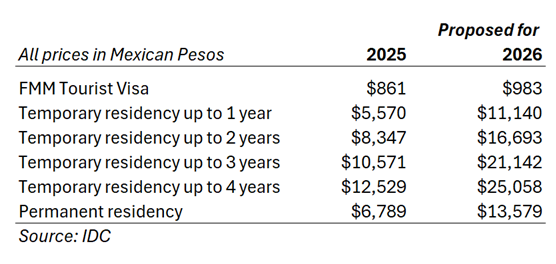A surprising item in the Morena Party’s proposed 2026 federal budget is a doubling of the fees foreigners would pay to INM (Mexican Immigration) for their temporary and permanent residency visas. According to the government, the sharp fee increases are necessary to address the impact foreign residents have on infrastructure, housing, and the local economies in the places they choose to reside.
Below, I’ll share what has been proposed, which fees are affected, and when they’re likely to take effect. To be clear, this has nothing to do with the financial qualifications for Mexican residency (which haven’t been announced yet for 2026), but the fees associated with obtaining legal residency.
Who Is Affected by the Proposed Fee Increases?
There are three large groups of foreigners in Mexico set to be impacted by the government’s proposed new fees.
- Tourists who fly into Mexico, and anyone who visits for more than 7 days
- People who need to renew their Temporary Residency card in 2026 and beyond
- People converting from Temporary to Permanent Residency in 2026 and beyond
The government argues that expat residents must contribute in proportion to their impact—a vague reference to the highly contentious situation in a handful of major cities (notably in CDMX and Guadalajara), where locals are effectively being priced out of desirable neighborhoods.
Since many foreign residents do not pay income or property taxes to the Mexican government, these fees represent an easy way to ensure that a majority of the immigrant community (particularly its newest residents) contributes more money to public coffers going forward.
Which Procedures Would See Price Increases
The table below compares the current fees for 2025 with the proposed new fees for 2026.
The Proposed Increases in Mexican Immigration Fees by Type

The cost of an FMM Tourist Visa is expected to increase to $983 pesos from $861 pesos currently. In U.S. dollars, this equates to a fee of roughly $53 per person, up from $47.
For first-year Temporary Residency applicants, the fees paid to INM are proposed to increase from $5,570 pesos to $11,140 pesos, or from about $303 USD to $606 USD per person. And as is typical, following year 1, a foreigner holding TR typically renews their residency for 3 more years (the maximum allowed).
The 3-year renewal fee is set to surge from $10,571 pesos to $21,142 pesos, or from about $575 USD to $1,150 USD per person. Ouch.
Certain applicants may be eligible for discounts of up to 50% on the new fees for humanitarian or family reunification purposes, but no details have been finalized yet.
If I were just starting and looking at the proposed 2026 fee schedule, I’d seriously consider applying for Permanent Residency from the start. This would enable someone to avoid all the recurring fees associated with temporary residency. Based on the fee schedule above, that approach could result in roughly $620 USD in savings per applicant. (i.e., the difference between TR fees up to four years versus the PR one-time fee)
How’s that possible? Because Permanent Residency does NOT require renewal. Once a foreigner secures their Permanent Residency card, there are no more fees. It’s a “one and done” procedure.
The only exception would be if you lose your PR card and need to apply for a new one.
Of course, taking a direct path to Permanent Residency means being able to meet the higher financial qualifications.
For some context, the proposed new fees for Mexican immigration procedures aren’t particularly high relative to other Latin American countries popular with U.S. and Canadian expats. In Costa Rica, immigration fees for new applicants hover around $1,000 USD, while in Panama, they are commonly between $1,000-$3,000 USD per person.
So in a sense, foreign residents in Mexico have been getting a bargain in recent years.
How Immigration Fees Get Applied
Most foreign tourists pay the FMM fees when buying their plane tickets to Mexico.
For visitors who enter Mexico by land, they get paid at a border crossing, provided that their stay is longer than one week. For shorter visits by land, the immigration fee is often waived.
The fees associated with temporary and permanent residency get paid directly to INM when you request your initial card in year one, as well as when you return for renewals — or to convert your status from temporary to permanent, which typically happens at the four-year mark.
Incidentally, the proposed 2026 budget also contains new procedures and fees targeting wealthy foreigners entering Mexico on private flights — closing a longstanding loophole.
Are the Fee Increases a Done Deal?
No, but I wouldn’t count on them getting scrapped.
These fee hikes proposed by President Scheinbaum’s Ministry of Finance are an important signal to voters that the government is listening to the public’s frustration over rapidly rising living costs, with the recent anti-gentrification rallies becoming a flashpoint.
Because Mexico is essentially a one-party state now, with the Morena party holding 73% of the seats in Congress, there’s little likelihood of it fundamentally changing.
When Will the New Fees Take Effect?
Debate on the new 2026 budget has already begun, but Congress has until the end of December to pass the measure.
If the new fees are adopted, they would go into effect beginning on January 1, 2026. And while the fee changes aren’t likely to pose a real hardship on most foreign residents, they do illustrate one more way that Mexico is becoming more expensive for the foreign community living here.
Sources: IDC, Mexico News Daily

